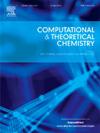基于含3-羟基-4-吡啶酮的五铜(II) 12-MC-4金属大环的超分子组装计算预测
IF 3
3区 化学
Q3 CHEMISTRY, PHYSICAL
引用次数: 0
摘要
DFT计算预测了含铜(II)的β-丙氨酸-羟基肟- 12-金属冠-4 (12-MC-4)和3-羟基-4-吡啶酮(3,4- hps)的铜衍生物在分子体系中的关联。用QTAIM和RDG方法分析了形成系综的非共价相互作用。在揭示的关键接触中,有NH2, OC(O)型氢键和顶端CuO相互作用。ELF显示了12-MC-4中中心Cu2+离子与铜酸盐配位环境的差异。提出了晶体相中系综排列的可能模式。根据NH2⋯OC(O)和CuO相互作用形成的空间结构和计算的偶极矩,预测模式为一维和二维堆积。PBE0/DGDZVP对12-MC-4和铜离子在甲醇极性介质中形成相应分子体系的能量变化分别为0.7和- 19.2 kcal/mol。将PBE0结果与使用相同基集的TPSSH计算结果进行比较。本文章由计算机程序翻译,如有差异,请以英文原文为准。

Computational prediction of supramolecular assembly based on pentacopper(II) 12-MC-4 metallamacrocycles with 3-hydroxy-4-pyridinone moieties
DFT calculations predict an association of the copper(II)-containing β-alaninehydroxamic 12-metallacrown-4 (12-MC-4) and cuprate derivatives of the 3-hydroxy-4-pyridinones (3,4-HPs) in molecular ensembles. Noncovalent interactions forming the ensembles are analyzed with QTAIM and RDG approaches. Among the crucial contacts revealed are hydrogen bonds of the NH2⋯OC(O) type and apical Cu![]() O interactions. Differences between the coordination environments of the central Cu2+ ion in 12-MC-4 and cuprates are displayed by ELF. Possible patterns of an ensemble arrangement in a crystal phase are suggested. On the basis of spatial structures formed by the NH2⋯OC(O) and Cu
O interactions. Differences between the coordination environments of the central Cu2+ ion in 12-MC-4 and cuprates are displayed by ELF. Possible patterns of an ensemble arrangement in a crystal phase are suggested. On the basis of spatial structures formed by the NH2⋯OC(O) and Cu![]() O interactions and computed dipole moments, the patterns are predicted to be of 1D and 2D packing. Energy changes on formation of corresponding molecular ensembles from separate 12-MC-4 and cuprate species in the polar medium of methanol are 0.7 and −19.2 kcal/mol by PBE0/DGDZVP. The PBE0 results are compared with TPSSH calculations employing the same basis set.
O interactions and computed dipole moments, the patterns are predicted to be of 1D and 2D packing. Energy changes on formation of corresponding molecular ensembles from separate 12-MC-4 and cuprate species in the polar medium of methanol are 0.7 and −19.2 kcal/mol by PBE0/DGDZVP. The PBE0 results are compared with TPSSH calculations employing the same basis set.
求助全文
通过发布文献求助,成功后即可免费获取论文全文。
去求助
来源期刊

Computational and Theoretical Chemistry
CHEMISTRY, PHYSICAL-
CiteScore
4.20
自引率
10.70%
发文量
331
审稿时长
31 days
期刊介绍:
Computational and Theoretical Chemistry publishes high quality, original reports of significance in computational and theoretical chemistry including those that deal with problems of structure, properties, energetics, weak interactions, reaction mechanisms, catalysis, and reaction rates involving atoms, molecules, clusters, surfaces, and bulk matter.
 求助内容:
求助内容: 应助结果提醒方式:
应助结果提醒方式:


